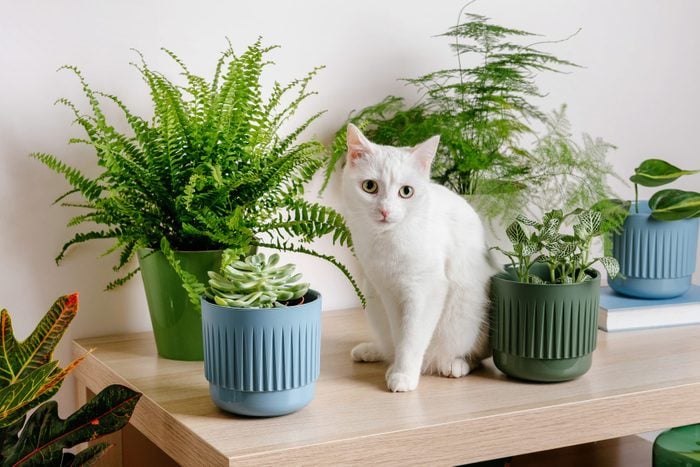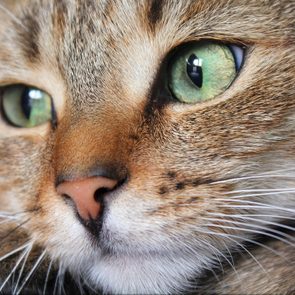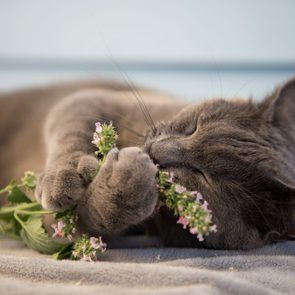How to Keep Cats Away from Plants and Protect Your Indoor Oasis
Updated: Apr. 24, 2024

Learn six effective techniques for how to keep cats away from plants—plus five methods you should never try
Living with a cat is quite the experience. One minute they’re curled into a ball under a sliver of sunlight they’ve found on the couch, and the next they’re pawing at the prized plants you’ve been working hard to keep alive. If your otherwise-sweet feline has ruined more than a few of your leafy friends, know that you’re one of many annoyed cat parents. It can feel like a lot to sort out how to keep cats away from plants, but there are effective steps you can take to squash this cat behavior.
First, it helps to understand why cats love plants. Cat behaviorist Stephen Quandt, founder of Stephen Quandt Feline Behavior Associates, says there are a few key factors. Smell is one—cats have a nose that’s 14 times stronger than a human’s—and indoor plants simply look and smell like tasty snacks.
Even though cats are true carnivores, they may have other instinctive reasons for eating plants. “Fiber in plants helps with intestinal motility, and plants may have some nutrients that cats benefit from. Also, some plants may just taste good to cats,” Quandt says. Another factor is that their appearance is intriguing. Quandt explains that many household plants are green, and while cats can’t see all colors well, green and yellow are two colors they can see clearly. And let’s not forget, cats simply love to knock things over.
So what’s the secret to learning how to keep cats out of plants? These tips and tricks can help. And once you’re up to speed, read up on how to keep cats out of your yard and how to train a cat too.
Train your cat to leave plants alone
Simple cat training via what’s known as remote correction is another technique you can use when learning how to keep cats away from plants. Quandt recommends using a motion-activated air spritzer that’s triggered when your cat comes near the device, such as PetSafe SSSCAT Motion-Activated Dog & Cat Spray. “It releases a harmless squirt of air at your cat, which will be startled and will move away from the plant,” he says.
Pro tip: If you happen to be around when this happens, you can gently pick up your cat and relocate them to a plant they are allowed to eat. This shows them there is a better alternative.
Wrap tin foil around your plant pots
Cats do not like the feeling of aluminum foil and will avoid it at all costs—it’s sort of like nails on a chalkboard for them. So to keep cats out of plants, try wrapping the pots in aluminum foil. If your cat likes digging into the soil—or maybe even uses it like a litter box—cover the dirt with aluminum foil too.
Pro tip: You can also use this technique as a way to keep cats away from the Christmas tree, which is particularly enticing, with all its shiny baubles.
Spray a yucky-tasting repellent
A quick spritz of a foul-tasting cat repellent on your plants—such as Grannick’s Bitter Apple or NaturVet Bitter Yuck!—can help tremendously. “The best way to convince a cat not to go after your plants is to make the plant completely unappealing,” says Quandt. “Both of these products taste terrible and are safe for cats and plants.” You can also use a 50/50 mix of vinegar (or lemon juice) and water. All these cat-safe repellents are also effective for keeping a cat from scratching furniture.
Pro tip: Re-apply at least daily—or even twice daily—during the training period. Once your cat has gotten the message, you may be able to taper off the spray.
Move plants to an inaccessible location
This may sound pretty obvious, but sometimes the best method for how to keep cats away from plants is to simply relocate them. When it’s out of sight and out of reach, your feline will focus their attention elsewhere. “Height is your friend, so find spots, plant stands or even hanging baskets that can be kept near windows,” suggests Quandt. You can also try making a greenhouse cabinet for your plants, or keeping your plants in a room the cats don’t have access to.
Pro tip: Suspend plants rather than keeping them on surfaces. Place a plant in a macramé holder and hang it from the ceiling.
Make it tricky to get close to the plant
Sometimes you want to keep your beautiful plants on display in the bedroom, living room, bathroom and wherever else you want to make greener. While high spots and hanging plants can help, another trick you can use to keep cats away from plants is to introduce obstacles that make it harder for your cat to get close to the plant. This might look like filling a shelf with other decor items to prevent your cat from sitting there and chomping away.
Pro tip: Keep your plant away from any potential “launch zones” that make it easier for your cat to access the plant. For example, if you keep plants on the fireplace mantel, don’t put a cat tower right below it.
Give them a plant they can eat
Anytime we take something away from our cat, it’s good to give something back. It’s like taking away an enticing toy from a baby but giving them something else to distract and satisfy. Quandt suggests putting some tasty wheat grass near the plant your cat wants to eat, which hopefully has more appeal in terms of taste (especially if the other is sprayed with a yucky solution). Another plant option is fresh catnip.
Pro tip: Be careful about which plants you introduce to your home. “Many houseplants are toxic to cats, some very much so [like almost all lilies],” Quandt says. “Lilies are so dangerous that if someone gives them to me, I will smile, thank them, and as soon as they leave, I throw them in a covered trash bin.”
What shouldn’t you use to keep cats away from plants?
Stick with the ideas we’ve shared above, and make sure you avoid the following tactics:
Spraying your cat with a water bottle
Do not do this—we all know how much most cats hate water. “This teaches your cat to avoid you as much as the plant, and they will learn that they can still munch on their veggies when you’re not around,” Quandt says.
Punishing your cat
You might feel frustrated—and that’s totally understandable—but punishing your cat for eating or pawing at your plants isn’t helpful. This includes light tapping or swatting, or shutting them in a room somewhere. “Cats are not biologically or evolutionarily programmed to understand punishment,” says Quandt. In other words, this tactic doesn’t work, and it negatively impacts your bond. On that note, pay attention to your cat’s body language to get a better idea of how they’re feeling.
Making loud noises
Similarly, avoid using loud noises to scare your cat away from the plants, like clapping, stomping and yelling. The noise might temporarily scare the cat, but they will associate the noise with you—not the plant. It’s better to use positive reinforcement with cats.
Misting diluted essential oils
There’s some bad advice out there that recommends spraying diluted essential oils on plants to act as a cat repellent (citronella and peppermint are two examples). Quandt says this may deter some cats, but in the event that it doesn’t, these essential oils are extremely toxic to your furry friend.
Using cayenne pepper
Similarly, cayenne pepper is often recommended as a natural cat repellent for plants, but this substance can irritate your cat’s paws. Don’t spray it or put it in the pot.
About the expert
- Stephen Quandt is the founder of Stephen Quandt Feline Behavior Associates and is a Feline Training and Behavior Specialist certified through the Animal Behavior Institute. He is a professional cat behaviorist with more than 20 years of experience working with cats in private consultations, animal shelters and rescue work with the ASPCA and Animal Care Centers of NYC. He is the owner of two cats, Jenny and Cricket.





















